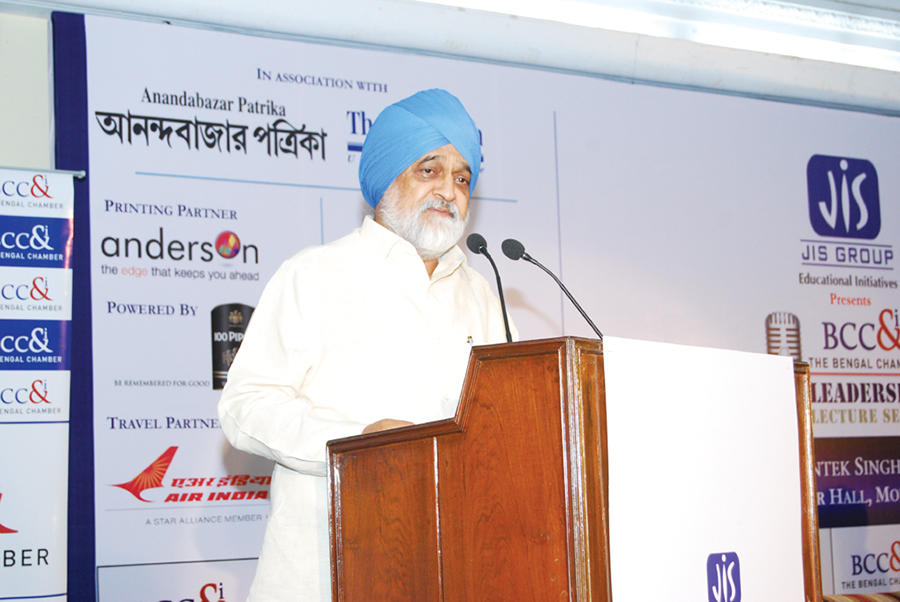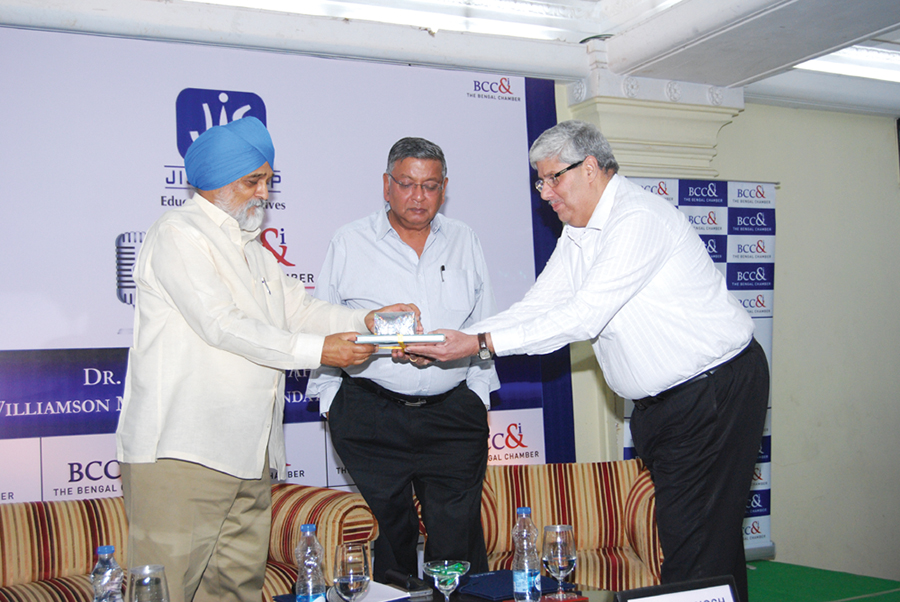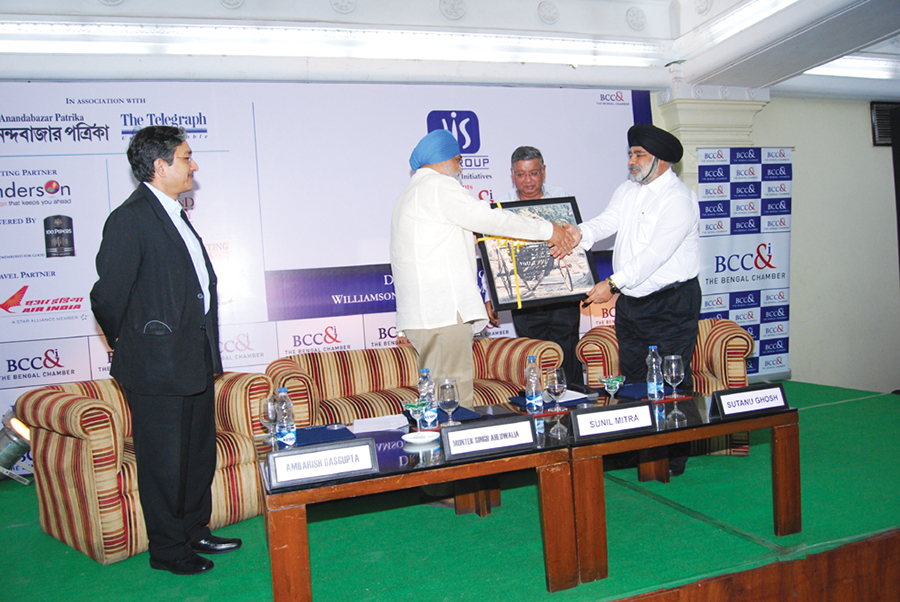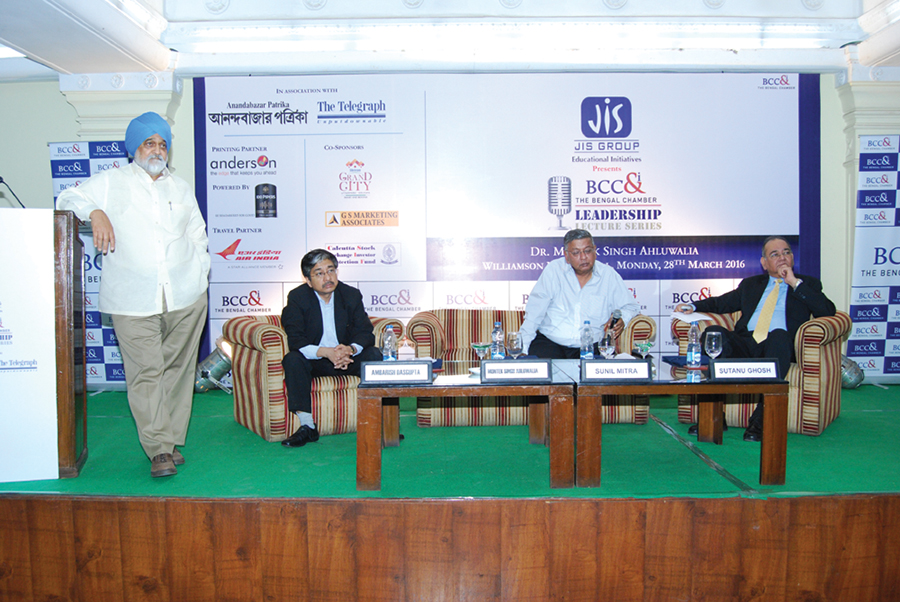- BCC&I Leadership Lecture Series with Dr. Montek Singh Ahluwalia, 28th March 2016, Chamber Premises
The Inaugural Edition of Leadership Lecture Series of The Bengal Chamber of Commerce and Industry commenced with an enlightening talk by Padma Vibhushan Dr. Montek Singh Ahluwalia, former Deputy Chairman of the Planning Commission, followed by an invigorating interactive session at the Chamber Premises on 28th March, 2016.
In his welcome address, the President, Mr Ambarish Dasgupta, stated that The Bengal Chamber of Commerce has traditionally been a forum for stalwarts to meet and share perspectives on industry, trade and developmental issues. The Chamber was honoured to have Dr. Ahluwalia as the luminary in the inaugural edition of the Leadership Lecture Series to which the Chamber would be inviting eminent knowledge experts and thought leaders to deliberate on subjects of immediate relevance. Further, it would also provide the industry leaders, academicians and eminent people across various fields, the opportunity to share their thoughts with the invited speakers and apprise them about the activities happening in this part of the country.
Mr Sunil Mitra, Chairperson, Economic Affairs Committee, in his address stated that while India’s structural economic processes has yielded results by way of increase in FDI and global rating agencies and institutions reviewing their earlier pessimistic assessments and also the Aadhar movement which has made a substantial headway, India still had a long way to go. The country presently seemed to be at a cross road as far as economic development was concerned.
Starting his speech, Dr Ahluwalia stated that he felt greatly honoured to be the First Speaker at The Bengal Chamber Leadership Lecture Series and to be at this impressive Heritage Building of the Chamber. Dr. Ahluwalia’s gripped the interest of the audience throughout his address which covered an analysis of the economic reform process and its slow outcome initially. He then made a detailed analysis of the country’s GDP growth story and his own theory on how to maintain and sustain a GDP growth of around 7.5% to 8% per annum and bringing about inclusive growth as well in the process. The highlights of his talk are summarized below:
In the last 10 years or so, the global perception of India has improved substantially. Globally, people perceive India very differently as compared to what it was a few years back. This happens to be the 25th year of liberalization of the Indian economy. However, the impact of what was done in the 90s was not felt immediately. The rate of change for the better had been slower than what it was expected to be.
From 2003 onwards right up to the global financial crisis in 2008, the economy grew faster than ever, at about 8% per annum. The Indian economy also slowed down due to global factors, but picked up quickly. The Indian economy during this time grew at 7.7% per annum. The only economy which did better was China. We are about 1/4th of China’s size but still it is a significant economy growing at 7.7%. We should remain on the ball and remain doing the right things and we should keep growing at that rate. However, global growth prospects have deteriorated.
In the developing economies, countries heavily dependent on commodities are not benefiting. China has grown for 13 years at 10% and is now slowing down. They have been able to capitalize on the growth that has happened. However, the impact on their domestic demand has been negative. This year their growth rate has been about 6.5%.
The next question to be asked is whether it is really true that China or other countries will slow down and at the same time India will continue to grow. Dr. Ahluwalia felt that growth will depend on increase in exports and managing balance of payments. Currently global growth prospects have depreciated. The mood in the industrialized world is negative. Decline in oil and commodities prices has helped India. If oil prices remain low the balance of payment problem can be tackled. The other positive factor for India has been that a positive message has gone out to the world through multiple changes in the Government that India welcomes FDI. However, poor infrastructure, poor logistics and overall lack of ease of doing business are our domestic constraints.
As far as the GDP growth of the country is concerned, the 12th Plan, as it began was quite optimistic. The growth target has been fixed to about 8%. It is not difficult to focus on a figure of 8% to 9%. According to his views right now, globally what people think is if we can follow sound policies and maintain the pace of reforms we can surely continue with a growth rate of about 7.5%. This forecast is based on continuing reforms triggering productivity.
The role of productivity in growth process needs to be focused on and understood. If India’s productivity growth improves and if it can go up to at 2% to 2.5% from 1% per year then India’s GDP growth rate can be 7.5%. Therefore, even to achieve this 7.5% growth there has to be an improvement in the underlying growth of what is called Total Factor Productivity which implies decomposition of growth of capital input and growth of labour input. Our capital investment is much more as we are far from the growth frontier and there is scope for catching up and leap frogging. Around 32 to 34% of GDP goes into investment in capital. The system is flexible enough for technology changes to be brought in.
Dr Ahluwalia felt very clearly on what India now needs to do in order to be on the growth path. He felt that India needs:
(1) Macro-economic balance; otherwise everything gets disrupted. The Government should ensure macro-economic balance.
(2) Development of infrastructure which is poor now. Infrastructure means power and logistics. Improvement should be such that it could enable integrated movement. Systems response in infrastructure is important.
(3) Ease of doing business. A list of necessities which businessmen talk about. Each State should promise that in a short time frame what will be on offer. Presently States are competing against each other which has been an important development.
(4) The new phenomenon has been that progress in industries is not going to come from traditional big industrial houses. They are not going to be the ones that are going to produce jobs in the scale that we need. Not much has been done to build up an environment for startups. Startups think that they are smarter than legacy systems in the space of startups. Both Central and State Governments need to focus on what is needed to be done. By small and medium we have meant unviable miniscule industries. We however have reasonably bigger concentration of larger entities. We do not have small and medium really. Our policy has been a multiplication of low technology small scale operation that are not being able keep pace with the rest of the system.
(5) ‘Financial Inclusion’. This has been given a lot of emphasis by the present Government. The number of people included in the banking system is very small. Technology enablers with Aadhar linkages have enabled more people to be brought under the banking system. 900 million people have been covered under Aadhar. Gradually all subsidies and payments like NAREGA payments can be done through Aadhar based bank accounts. The robust ‘one person one identity’ enabled environment will open up several avenues and seal leakages. A person can use his entire financial records available through the system to access credit requirements.
Road Ahead
Dr. Ahluwalia listed agriculture, banking, infrastructure and skill development as the areas that the government should focus on to drive growth. Noting that agriculture growth was lagging, he stressed the need to improve the farm market, enhance rural road connectivity and focus on agri research. In banking, he argued the government has to find a way around the mess over bad loans with appropriate haircuts (for lending institutions) and penalties (for promoters).
The 1st Leadership Lecture Series was presented by JIS Group, in association with ABP & The Telegraph.

 Annual General Meeting 2015
Annual General Meeting 2015 Agro and Rural Development
Agro and Rural Development City of Analytics
City of Analytics Economic Affairs
Economic Affairs Education
Education Entrepreneurship Development
Entrepreneurship Development Energy and Environment
Energy and Environment Exhibitions and Trade Fairs
Exhibitions and Trade Fairs Finance and Banking
Finance and Banking Health
Health HR / IR
HR / IR Information Technology
Information Technology Infrastructure
Infrastructure International Relations
International Relations International Trade Cell
International Trade Cell Leadership Lecture
Leadership Lecture Legal
Legal Metals & Mining
Metals & Mining MSME Development, Manufacturing and Allied Activities
MSME Development, Manufacturing and Allied Activities North Bengal
North Bengal Projects
Projects Shipping
Shipping Skill Development
Skill Development Social and Cultural
Social and Cultural Sports
Sports Taxation
Taxation Think Series
Think Series Tourism and Heritage
Tourism and Heritage Training Programmes and Workshops
Training Programmes and Workshops Other Programmes
Other Programmes Press Clippings
Press Clippings Appendix
Appendix Download
Download





